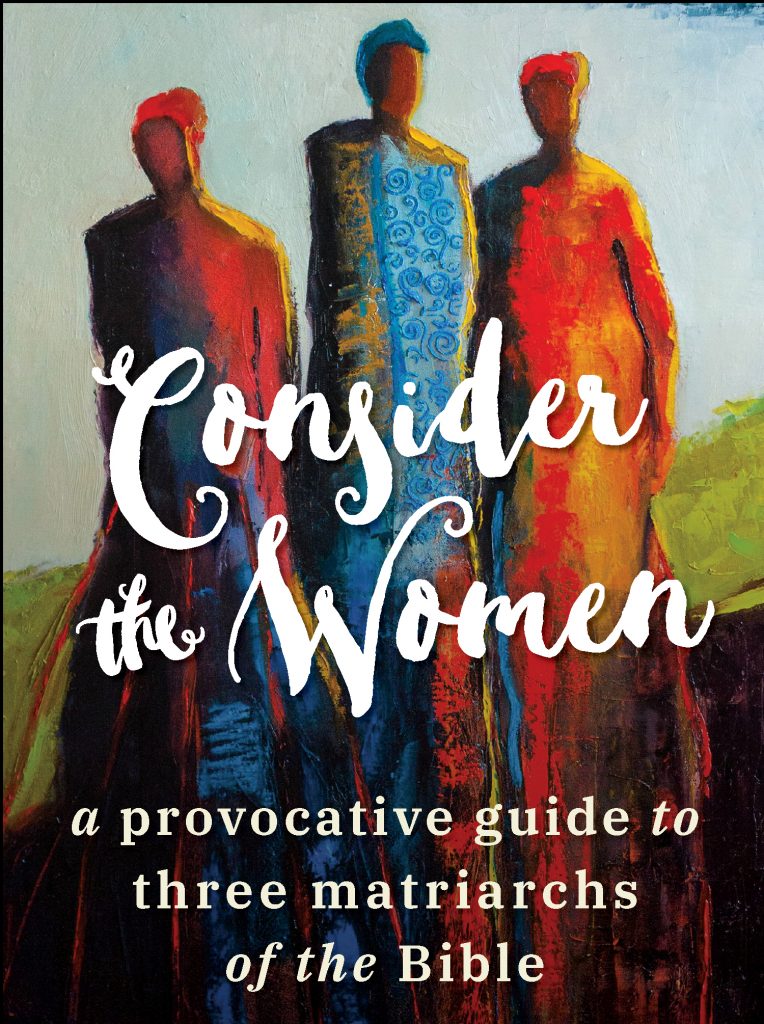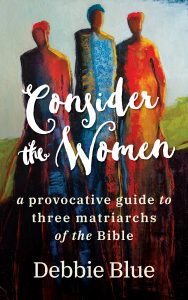
by Elizabeth Felicetti
“The Bible invites—almost demands—our questions,” writes Lutheran pastor Debbie Blue in Consider the Women: A Provocative Guide to Three Matriarchs of the Bible. Faithful Christians, lay and ordained, can safely bring their questions to this book, which considers Hagar, Esther, and Mary the mother of Jesus in light of the Abrahamic faiths. In addition, Blue believes “Scripture loses some of its capacity for revelation if we don’t enter it honestly as women weary of patriarchy or as people who have seen so much injustice go down that they will never stop questioning authority.” Blue weaves biblical scholarship alongside memoir in this powerful follow up to her book Consider the Birds: A Provocative Guide to Birds in the Bible in 2013.
Part One contains two chapters on Abrahamic Faith, the first embracing the patriarch’s sojourning faithfulness by setting a course to wander among biblical women, and the second chapter positing that an emphasis on monotheism edged out God’s feminine sides, even as the Bible contains feminine imagery for God.
Part Two focuses on Hagar, first pointing out the subversive and opposing narratives that are often interwoven with the dominant narrative in the Bible. While Paul disparages Hagar as a slave in Galatians, and while reformers Luther and Calvin disdained her, Hagar is treated well in Genesis: she is the first person in the Bible visited by an angel, and she is the only person in the Bible who gave God a name: “The God Who Sees.”
Blue seeks out Muslim women willing to talk about Hagar, and quickly learns that many Muslim women know as little about Hagar as many Christians do about Abraham. She further discovers that some observant Muslim women consider stories about women who are the wives and daughters of Mohammed more important than stories about Hagar, despite Hagar’s prominence in the Koran. Blue’s journey into Hagar includes a trip to a mosque with her daughter and a fascinating conversation with a former Lutheran from Minnesota who, in her search for a more feminist religion than Christianity, ended up Muslim. Blue learns from this teacher that according to Islam, “Hagar’s expulsion from Abraham’s household isn’t an episode of female oppression, but part of God’s plan to establish a sanctuary in the desert along with rituals that pilgrims will follow as long as the world endures. Nor is Hagar a victim.”
Blue turns to Esther in Part Three of Consider the Women. She considers how many times men have wanted to cut Esther from the canon, starting with community at Qumran, who apparently did not include her book, considering that it is not among the Dead Sea Scrolls; Calvin, who did not write about it in his commentaries; and Luther, who was overt in his dislike. Blue points out that we need a matriarch like Esther: “a matriarch who is not a mother.” Amen! But our Revised Common Lectionary only features one snippet from the book of Esther in its three-year cycle.
Blue devotes a chapter to Purim, the popular Jewish holiday that embraces Esther’s story, and seeks out and recounts Purim experiences, and closes the section on Esther with the provocative chapter “Shoah: Scapegoating and Status Seeking.” She points out that while Christians have tended to be answer-oriented, Jesus asked more questions than he answered. Further, she wonders, “Perhaps if Esther were not so systematically ignored in Christianity, the story of Haman could have deterred the church from its persistent descents into anti-Semitism.”
Mary the mother of Jesus makes up the third member of this female trinity of biblical women and the final section of the book. Blue emphasizes the subversive nature of the mother of God, who is, after all, named after Moses’ sister Miriam, whose name meant “rebel.” Blue further points out that the high priest loses his place when Mary came along, and claims that the archbishop of Canterbury in the nineteenth century instructed missionaries to India not to read Mary’s words in that country in order to avoid inciting riots. Blue does make a small biblical error by confusing in passing Mary’s encounter with Simeon with looking for Jesus in the temple when he was twelve rather than when he was an infant, but this does not detract from her overall scholarship or theology.
Blue’s focus on these three women through the lens of Abrahamic tradition allows the reader to go in depth with each woman, unlike a sweeping “woman of the Bible” book that simply names each female character and retells her story, sometimes without nuance. In addition, Blue’s emphasis on what draws us together in an age of divisiveness, especially with Muslim faithful, makes this volume timely.
A twenty-eight page reader’s guide at the end of the book makes this ideal for book clubs, Bible studies, or adult formation church groups. This reviewer is now determined to select Esther for church Bible study in the next year as a result of reading this book.
Consider the Women: A Provocative Guide to Three Matriarchs of the Bible
Grand Rapids: Eerdmans, 2019
Elizabeth Felicetti is the rector of St. David’s Episcopal Church in Richmond, Virginia, and pursues an MFA in Writing at Spalding University in Kentucky. She reviews books for the Café, Kirkus Reviews, and Christian Century, and has essays forthcoming in the Westminster John Knox preaching commentary series Connections. She tweets @bizfel.


